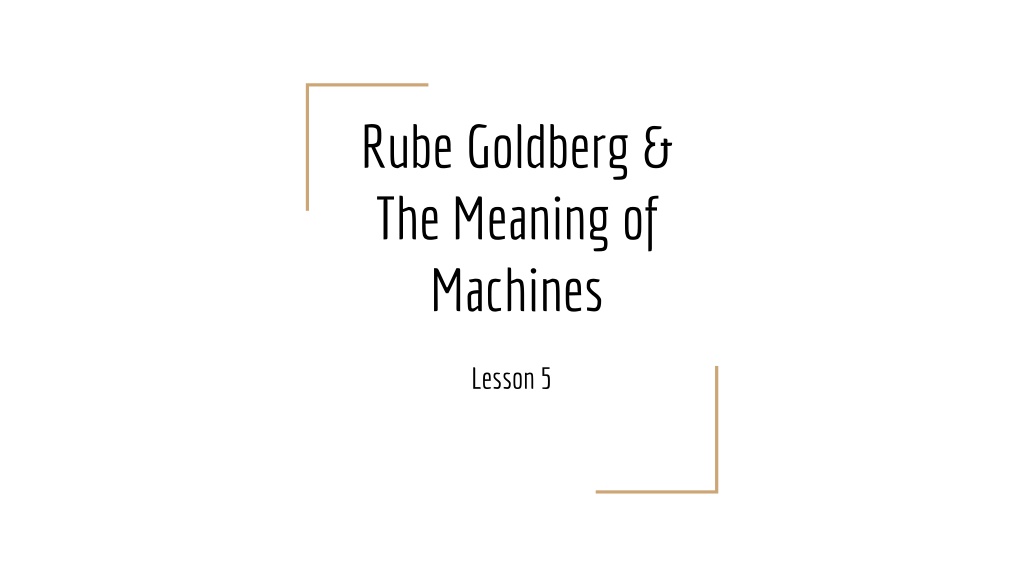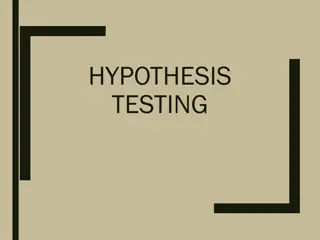Exploring Rube Goldberg's Self-Operating Napkin Machine
Delve into the whimsical world of Rube Goldberg's self-operating napkin machine, a complex yet entertaining creation that showcases the intricate interactions of simple machines to perform a seemingly simple task in a convoluted manner. Unravel the step-by-step process of how a series of actions are triggered by mundane movements, culminating in a napkin wiping your chin in a humorous and ingenious way.
Download Presentation

Please find below an Image/Link to download the presentation.
The content on the website is provided AS IS for your information and personal use only. It may not be sold, licensed, or shared on other websites without obtaining consent from the author. Download presentation by click this link. If you encounter any issues during the download, it is possible that the publisher has removed the file from their server.
E N D
Presentation Transcript
Rube Goldberg & The Meaning of Machines Lesson 5
Engineering Connection One engineering objective is to help people via technological advances. Many of these greater advances in technology can be seen in machines invented by engineers. Rube Goldberg went to school to be an engineer, and after graduating, he decided to become an artist. He drew cartoons of inventions that did simple things in very complicated ways. His inventions involved many complex systems of simple machines, all organized in logical sequences, to accomplish simple tasks. An important skill for engineers is to evaluate the design of machines for their genuine usefulness for their audiences. Often, the best design is the simplest design.
Figure 1. A Rube Goldberg cartoon of a self-operating napkin.
Introduction-Self Operating Napkin Let's look at this Rube Goldberg cartoon, the "Self-Operating Napkin." When an engineer designs a machine, she is concerned with how it will fit in with the owner's life or what positive meaning it will have for him. Most often, a machine must be practical in order for it to be used. What's the meaning of the self-operating napkin machine? Let's read through the step-by-step description so we can understand it better. [As a class, read the description: As you raise a spoon of soup (A) to your mouth, it pulls a string (B), thereby jerking a ladle (C), which throws a cracker (D) past a parrot (E). The parrot jumps after the cracker, and the perch (F) tilts, upsetting seeds (G) into a pail (H). The extra weight in the pail pulls a cord (I), which opens and lights an automatic cigar lighter (J), setting off a sky-rocket (K), which causes a sickle (L) to cut string (M), causing a pendulum with an attached napkin to swing back and forth, wiping off your chin.]
Introduction-Self Operating Napkin Obviously, the machine is complicated. Would you have been able to decipher all of the steps without the description just by looking at the machine? The simple machines (the ladle, parrot, cigar lighter, etc.) interact with one another in a way that is not immediately apparent, and the end function of the machine is not obvious either. Until we understand what the machine does, this compound machine remains fairly meaningless that is, it is really just a funny hat atop a man's head. After we have read the description of the "Self-Operating Napkin," it seems that all the steps fit together, similar to all the different motions within a bicycle, where one simple machine interacts with another to contribute to some end function. Considering that a bicycle takes us from one point to another, which is quite useful, why wouldn't people find this napkin-machine useful? (Although the self-operating napkin might make work easier for us by definition, it probably takes more work to merely hold the machine on your head!) --->(Next, look at the "Self-Opening Umbrella" cartoon, Figure 2.)
Figure 2. A Rube Goldberg cartoon of a self-operating umbrella.
Introduction Continued Do these cartoons remind you of machines or devices in your life? Maybe it reminds you of the new electronically powered transportation device that is supposed to whisk you around a city as you stand or an old camping tent that fits together in a way that still takes forever to figure out. It is easy to see why you would be reminded of these things by the Rube Goldberg cartoons; his images depict machines that do jobs always in the most complicated ways. Can you think of other machines that you have seen that do not have much useful meaning? ( Possible answers: Electric eraser, towel warmer, electric can opener.) Who remembers the concept of mechanical advantage? Mechanical advantage is a mathematical expression for how much easier a machine makes work. How do we find the mechanical advantage of a compound machine? Do we simply add the mechanical advantages of each simple machine? No, we multiply the separate mechanical advantages. Engineers use the product of the values of mechanical advantage to explain why a compound machine is many times more useful than a single simple machine. Would these Rube Goldberg inventions have a small or large mechanical advantage? (Answer: Probably large, since they involve so many simple machines.) Why are they not realistic for the user? (The machines may be too complex, clunky and weigh a lot to be really useful.) Why is mechanical advantage not always the best way to measure the value of machines? (In these examples, the added complexity outweighs the benefits of the machine. A person would have to exert more effort to use the machine than is needed just to perform the simple task without the machine.)
And so Engineers must have clear ideas about how their machines will benefit people; otherwise, they are unlikely to be used. As suggested by the Rube Goldberg cartoons, which seem to exaggerate bad designs, engineers should aim to design machines that fit in well with a person's activities and therefore somehow improve that person's life. In general, the simplest designs are the best. Even in complex machines, the simpler the individual components, the easier it is to make the machine, and the more reliable it is. Use your knowledge of simple and compound machines to design and build a Rube Goldberg machine!
Vocabulary/ Definitions compound machine: A machine that consists of two or more simple machines and allows for work to be done easier. mechanical advantage: The number of times a force exerted on a machine is multiplied by the machine. Rube Goldberg: Cartoonist and engineer who poked fun at overly complicated machines; a machine that operates in a complicated way in which the procedure could have been much simpler. simple machine: The fundamental parts of any machine. Simple machines can exist on their own and are also sometimes hidden in the mechanical devices around you; a device that performs work by increasing or changing the direction of force, making work easier for people to do.























